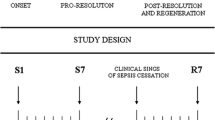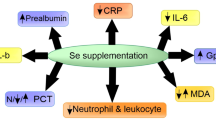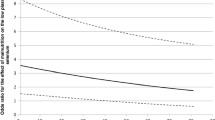Abstract
Objectives
To confirm the influence of systemic inflammatory response syndrome (SIRS) on selenium (Se) levels and prospectively evaluate the relationship between serum Se concentration [Se], glutathione peroxidase activity [GPx-3] and injury severity in patients at the time of intensive care unit (ICU) admission.
Design
Prospective, observational study.
Setting
Multidisciplinary University Hospital ICU.
Patients and participants
A total of 36 ICU patients and 23 healthy volunteer subjects (HVS).
Measurements and results
Healthy volunteer subjects were designated as controls (Group 1). ICU patients were divided into three groups: without SIRS (Group 2); with SIRS (Group 3); with SIRS and multiple organ dysfunction syndrome (MODS) (Group 4). The latter groups had APACHE II scores >15. [GPx-3] and [Se] were determined by standard methods within the first 48 h of admission to ICU. Kruskal–Wallis and Mann–Whitney U test were used for analysis of non-parametric continuous variables. The predictive value of [Se] and [GPx-3] for SIRS was calculated using a receiver operating characteristics (ROC) analysis. In SIRS and MODS patients [GPx-3] and [Se] decreased significantly (P = 0.0001 and P = 0.002, respectively). After ICU admission [GPx-3] and [Se] had a predictive value for SIRS ([GPx-3] sensitivity: 90%, specificity: 86.2% (cut-off value: 0.5 U/mL); [Se]: sensitivity 90%, specificity 72.4% (cut-off value: 60 μg/L). [Se] had predictive value for ICU mortality (P = 0.034).
Conclusions
Systemic inflammatory response syndrome and MODS were associated with early decreases in [Se] and [GPx-3]. Low [Se] and [GPx-3] after ICU admission had a predictive value for SIRS, which may aid future selection of patients who could benefit from Se supplementation.





Similar content being viewed by others
References
Rayman MP (2000) The importance of selenium to human health. Lancet 356:233–241
Hardy G, Hardy I (2004) Selenium: the Se-XY nutraceutical. Nutrition 20:590–593
Burk RF (2001) Selenium: recent clinical advances. Curr Opin Gastroenterol 17:162–166
Forceville X (2001) Selenium and the «free» electron. Selenium—a trace to be followed in septic or inflammatory ICU patients? Intensive Care Med 27:16–18
Shenkin A, Allwood MC (2001) Trace elements and vitamins in adult intravenous nutrition. In: Rombeau JL, Rolandelli RH (eds) Clinical nutrition: parenteral nutrition, 3rd edn. Saunders, Philadelphia, pp 60–79
Members of the American College of Chest Physicians/Society of Critical Care Medicine Consensus Conference (1992) Definitions for sepsis and organ failure and guidelines for the use of innovative therapies in sepsis. Crit Care Med 20:864–873
Goodyear-Bruch C, Pierce LD (2002) Oxidative stress in critically ill patients. Am J Crit Care 11:543–551
Grune T, Berger MM (2007) Markers of oxidative stress in ICU clinical seetings: present and future. Curr Opin Clin Nutr Metab Care 10:712–717
Mishra V, Baines M, Wenstone R, Shenkin A (2005) Markers of oxidative damage, antioxidant status and clinical outcome in critically ill patients. Ann Clin Biochem 42:269–276
Berger MM (2005) Can oxidative damage be treated nutritionally? Clin Nutr 24:172–183
Victor VM, Rocha M, Esplugues JV, De la Fuente M (2005) Role of free radicals in sepsis: antioxidant therapy. Curr Pharm Des 11:3141–3158
Metnitz PG, Bartens C, Fischer M, Fridrich P, Steltzer H, Druml W (1999) Antioxidant status in patients with acute respiratory distress syndrome. Intensive Care Med 25:180–185
Flohé L, Andreesen JR, Brigelius-Flohé R, Maiorino M, Ursini F (2000) Selenium, the element of the moon, in life on earth. IUBMB Life 49:411–420
Dodig S, Cepelak I (2004) The facts and controversy about selenium. Acta Pharm 54:261–276
Maehira F, Luyo GA, Miyagy I, Oshiro M, Yamane N, Kuba M, Nakazato Y (2002) Alterations of serum selenium concentration in the acute phase of pathological conditions. Clin Chim Acta 316:137–146
Schomburg L, Schweizer U, Kohrle J (2004) Selenium and selenoproteins in mammals: extraordinary, essential, enigmatic. Cell Mol Life Sci 61:1988–1995
Papp LV, Lu J, Holmgren A, Khanna KK (2007) From Selenium to selenoproteins. Synthesis, Identity and their role in human health. Antioxid Redox Signal 9:775–806
Néve J (2002) Selenium as a nutraceutical: How to conciliate physiological and supranutritional effects for an essential trace element. Curr Opin Clin Nutr Metab Care 5:659–663
Forceville X, Vitoux D, Gauzit R, Combes A, Lahilaire P, Chappuis P (1998) Selenium, systemic immune response syndrome, sepsis and outcome in critically ill patients. Crit Care Med 26:1536–1544
Alonso de Vega JM, Díaz J, Serrano E, Carbonell LF (2002) Oxidative stress in critically ill patients with systemic inflammatory response syndrome. Crit Care Med 30:1782–1786
Motoyama T, Okamoto K, Kukita I, Hamaguchi M, Kinoshita Y, Ogawa H (2003) Possible role of increased oxidant stress in multiple organ failure after systemic inflammatory response syndrome. Crit Care Med 31:1048–1052
Sakr Y, Reinhart K, Bloos F, Marx G, Russwurm S, Bauer M, Brunkhorst F (2007) Time course and relationship between plasma selenium concentrations, systemic inflammatory response, sepsis and multiorgan failure. Br J Anaesth 98:775–784
Manzanares W, Torre M, Biestro A, Mañay N, Pittini G, Facchin G, Rampoldi O, Hardy I, Hardy G (2008) Serum selenium and glutathione peroxidase activity in critically ill patients with systemic inflammatory response and multiple organ dysfunction syndromes. Nutrition 24:506–507
Bernard GR, Artigas A, Brigham KL, Carlet J, Falke K, Hudson L, Lamy M, LeGall JR, Morris A, Spragg R (1994) The American-European consensus conference on ARDS. Definition, mechanisms, relevant outcomes, and clinical trial coordination. Am J Respir Crit Care Med 149:818–824
Burk RF, Hill KE (2005) Selenoprotein P: an extracelular protein with unique physical characteristics and role in selenium homeostasis. Annu Rev Nutr 25:215–235
Gromer S, Eubel JK, Lee BL, Jacob J (2005) Human’s selenoproteins at a glance. Cell Mol Life Sci 62:2414–2437
Duffield AJ, Thomson CD, Hill KE, Williams S (1999) An estimation of selenium requirements for New Zealanders. Am J Clin Nutr 70:896–903
Geoghegan M, McAuley D, Eaton S, Powell-Tuck J (2006) Selenium in critical illness. Curr Opin Crit Care 12:136–141
Vincent JL, Forceville X (2008) Critically elucidating the role of selenium. Curr Opin Anesthesiol 21:148–154
Berger MM, Spertini F, Shenkin A, Wardle C, Wiesner L, Schindler C, Chiolero RL (1998) Trace element supplementation modulates pulmonary infection rates after major burns: a double blind, placebo-controlled trial. Am J Clin Nutr 68:365–371
Hawker FH, Stewart PM, Snitch PJ (1990) Effects of acute illness on selenium homeostasis. Crit Care Med 18:442–446
Angstwurm MW, Schottdorf J, Schopohl J, Gaertner R (1999) Selenium replacement in patients with severe systemic inflammatory response syndrome improves clinical outcome. Crit Care Med 27:1807–1813
Wereszczynska-Siemiatkowska U, Mroczko B, Siemiatkowski A, Szmitkowski M, Borawska M, Kosel J (2004) The importance of Interleukin 18, Glutathione Peroxidase and Selenium concentration changes in acute pancreatitis. Dig Dis Sci 49:642–650
Heyland DK, Dhaliwall R, Suchner U, Berger MM (2005) Antioxidants nutrients: a systematic review of trace elements and vitamins in the critically ill patient. Intensive Care Med 31:327–337
Angstwurm MW, Engelmann L, Zimmermann T, Lehmann C, Abel P, Strauss R, Meier-Hellmann A, Insel R, Radke J, Schüttler J, Gärtner R (2007) Selenium in Intensive Care (SIC) study: results of a prospective, randomized, placebo-controlled, multiple-centre study in patients with severe systemic inflammatory response syndrome, sepsis and septic shock. Crit Care Med 35:118–126
Mishra V, Baines M, Perry SE, McLaughlin PJ, Carson J, Wenstone R, Shenkin A (2007) Effect of selenium supplementation on biochemical markers and outcome in critically ill patients. Clin Nutr 26:41–50
Forceville X, Laviolle B, Annane D, Vitoux D, Bleichner G, Korach JM, Cantais E, Georges H, Soubirou JL, Combes A, Bellissant E (2007) Effects of high doses of selenium, as sodium selenite, in septic shock: a placebo-controlled, randomized, double-blind, phase II study. Crit Care 11:R73
Lindner D, Lindner J, Baumann G, Dauwczynski H, Bauch K (2004) Investigation of antioxidant therapy with sodium selenite in acute pancreatitis. A prospective randomised blind trial. Med Klin 99:708–712
Wang Z, Piagnerelli M, Ahishakiye D, Vincent JL, Forceville X, Antwerpen PV, Neve J (2008) High bolus dose of sodium selenite prolongs survival in an ovine model of septic shock. Crit Care Med 35(Suppl A60):12
Acknowledgments
We are indebted to Alejandro Ferreiro, MD for his collaboration in the data analysis. This project was supported by grants from the Comisión Sectorial para la Investigación Científica (CSIC), UDELAR and the Fondo Clemente Estable 2004/10.072, DICyT. Ministerio de Educación y Cultura, Uruguay.
Conflict of interest statement
All authors have no competing interests to declare.
Author information
Authors and Affiliations
Corresponding author
Rights and permissions
About this article
Cite this article
Manzanares, W., Biestro, A., Galusso, F. et al. Serum selenium and glutathione peroxidase-3 activity: biomarkers of systemic inflammation in the critically ill?. Intensive Care Med 35, 882–889 (2009). https://doi.org/10.1007/s00134-008-1356-5
Received:
Accepted:
Published:
Issue Date:
DOI: https://doi.org/10.1007/s00134-008-1356-5




